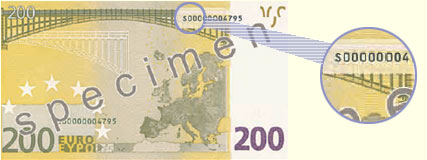43, avenue Monterey
L-2983 Luxembourg
From Monday to Friday:
10:30 a.m. - 4:00 p.m.

On the front of both series of euro banknotes, windows and doorways are shown. They symbolise the European spirit of openness and cooperation. The bridges on the back symbolise communication between the people of Europe and between Europe and the rest of the world.


The windows, doorways and bridges shown on the banknotes are stylised illustrations, not images of, or from, actual constructions. Other design elements are:
BCE: French, Italian, Portuguese, Romanian, Spanish
ECB: Czech, Danish, Dutch, English, Latvian, Lithuanian, Slovak, Slovene, Swedish
ЕЦБ: Bulgarian
EZB: German
EKP: Estonian, Finnish
EKT: Greek
EKB: Hungarian
BĊE: Maltese
EBC: Polish
Each banknote bears the signature of either Willem F. Duisenberg, Jean-Claude Trichet or Mario Draghi – the first, second and third Presidents of the European Central Bank respectively. These banknotes are all equally valid.
|
Willem F. Duisenberg |
Jean-Claude Trichet |
Mario Draghi |
The banknotes show a geographical representation of Europe.
The central bank that commissioned the printing of a banknote (but not necessarily the country of printing) is indicated by a letter or country code preceding the serial number, as shown here:

The serial numbers on this series are the two numbers printed on the back of the banknote: a horizontal number printed in black and a vertical number printed in a different colour.
The horizontal number comprises two letters and ten digits. The first letter identifies the printing works – see the list . The second letter has no particular meaning; it simply makes more serial numbers possible.